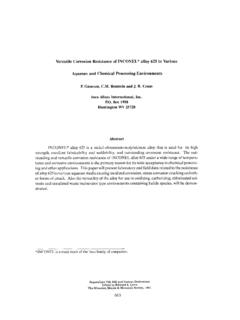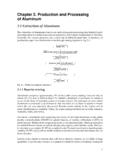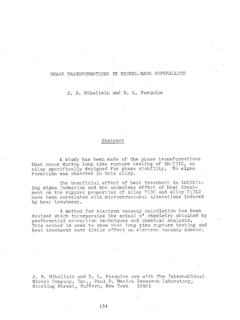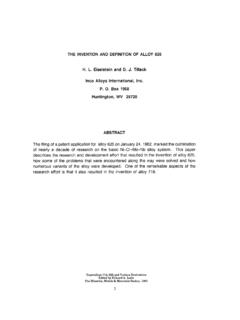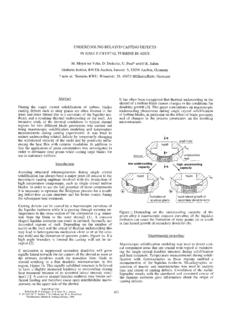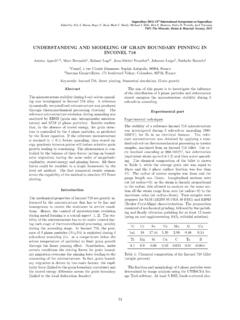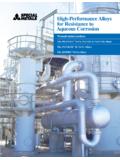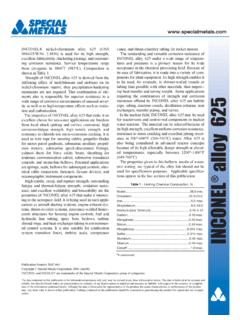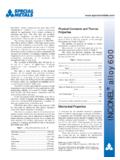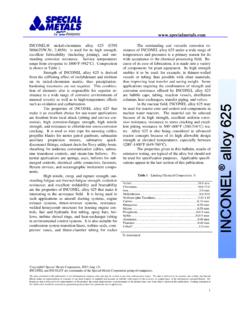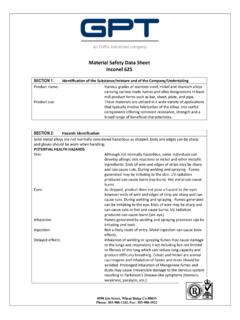Transcription of Effect of Heat Treatment Variations on the …
1 Effect of heat Treatment Variations on the Hardness and Mechanical Properties of Wrought InconeI718 John J. Schirra United Technologies Corporation - Pratt & Whitney Abstract The Effect of heat treat Variations within current specification tolerances on the hardness of wrought inconel 7 18 was evaluated. The statistically designed experiment identified cooling rate from solution heat Treatment as having the greatest impact on hardness with increasing cooling rate increasing fully heat treated hardness. A specimen test program was then initiated to determine the Effect of fast and slow cooling rates on mechanical properties. Slower cooling rates resulted in reduced creep rupture and yield strengths with no Effect on low cycle fatigue and fatigue crack growth properties. After thermal exposure (100 hours at 732 C) both sets of material exhibited comparable strength and stress rupture properties.
2 Superalloys 718,625, 706 and Various Derivatives Edited by Loria The Minerals, Metals &Materials Society, 1997 431 Introduction Wrought inconel 718 has evolved into a workhorse alloy for turbine engine applications for many reasons including affordability, weldability and a good balance of high temperature mechanical properties. However, some of the characteristics desirable for engine applications can result in producibility difficulties. If processed to increased hardness, the alloy can be extremely difficult to machine (ref 1). In addition, complex, welded assemblies can be prone to distortion when rapidly cooled from the solution heat treat cycle. To control distortion, the use of slower cooling rates is pursued, but there is frequently very little margin relative to specification requirements to air cool the alloy (AMS 5663).
3 The use of statistically designed experimental matrices has proved to be an efftcient technique in material process development (ref 2). They permit the screening of a large number of process variables, and when combined with a confirmation step, result in identification and control of the critical processing variables. The Taguchi based approach to experimental design (ref 3) has proven to be extremely valuable. This approach was utilized to assess the sensitivity of inconel 718 hardness on Variations that can occur in the heat Treatment of inconel 718. The processing steps in the heat treat cycle and levels of variation allowed by the specification are presented in Table I. Material hardness - & (Rockwell C) was selected as the response variable for the experiment. Table I AMS 5663 Specification heat Treatment Variables and Typical Ranges Details A heat of AMS 5662 was obtained ( heat PLNJ) and sectioned into heat treat cubes.
4 The chemistry for the heat is Table II Chemistry of AMS 5663 heat PLNJ used for The heat Treatment Processing Study. 1 Nb+Ta I 1 t Ti .79 I co .097 Ni I Bal presented in Table II. A Taguchi LS experimental matrix was selected for the experiment and the variables were assigned to assess the main Effect and some of the interactions of the factors listed in Table I. Details of each experimental run are presented in Table III. After heat Treatment , the material was metallographically prepared and direct Rockwell C hardness tests conducted (5 per sample). Hardness results are presented in Table IV. Review of the hardness results shows very little scatter within each run with a range of up to Rc between the lowest and highest hardness runs. Statistical analysis of the hardness results identified all factors except solution 432 Table III heat Treatment Processing Parameters for Taguchi L8 Experimental Runs 1 Run # 1 Solution Tema 1 Coolincz Rate 1 1 *Precipitation 1 2 d Precipitation 1 heat Up Rate 704T 607T 1 27X0(?)
5 / hnlw 1 941 C <6 C i minute I - - - ----- 1 I nnrom ,roc1 I -I1,?0 I r_l COT. rrr II L Y +l L -0 L / mlIlllLD /5L L 052 L 330-L 1 nour 3 941 C ,22 C I minute 704 C 635 C 556 C I hour 4 941 C >22 C I minute 732 C 607 C 278 C I hour 1 5 968 C <6 C / minute 704OC 607 C 556 C I hour I 6 I 9fx C I <hoc /minute I 732 C 635 C 278 C I hour 704OC I h35 c 1 378 C / 7 968 C >22 C / minute ___ - I __-I- 8 968 C >22T / minute 732 C 607 C 1 % c /hour 1) Material processed as follows: Solution heat treat at temperature listed followed by cooling at the rate listed. heat to the 1 precipitation temperature listed at the heat up rate listed and hold for 8 hours. Furnace cool at 56 Clhour to the 2 d precipitation temperature listed and hold for 8 hours. Air cool to room temperature Table IV Measured Hardness for the heat Treatment Runs Listed in Table III.
6 Temperature and heat up rate to the precipitation temperature as having a statistically significant Effect on fully heat treated hardness. Of the factors identified, cooling rate from solution heat Treatment had the greatest Effect ( Rc difference) with less than .5 Rc difference between the low and high levels (Table V) for the other variables. Table V Average Hardness at the Low and High Levels for the Experimental Factors Evaluated in Table III. 1) Interaction between the variables listed. Two verification heat treatments were defined to confirm the effects of the factors identified; the first was aimed at maximizing hardness ( hard run) with the second aimed at minimizing hardness ( soft run). The two cycles are compared in Table VI. Hardness testing (Table VII) verified the expected Effect of the heat treat cycles with a difference of slightly more than 2 & measured between the two processes.
7 To further veri@ the processing effects, the material processed through the hard heat treat was re- heat treated to the soft cycle. Hardness testing showed a 2 Rc reduction relative to the initial hard heat Treatment results. The two heat treat cycles were also verified in a shop furnace with test panels processed through both the hard and soft heat treat cycles. A difference of almost 3 Rc was observed between the two cycles in the shop trials. 433 Table VI Confirmation heat Treatment Process Parameters. Run #2 Solution Temp Cooling Rate lst Precipitation 2 d Precipitation heat Up Rate SOft 968 C <6 C / minute 732 C 635 C 278 C I hour hard 941 C >22 C I minute 704OC 607 C 556 C I hour soft3 968 C 16 C / minute 732 C 635 C 278 C I hour 1) See Table III note 1. 2j Soft run aimed at minimizing hardness and hard run aimed at maximizing hardness.
8 3) Material originally processed through hard parameters than re- heat treated to soft process parameters.. Table VII Measured Hardness for Material Processed Through heat Treatment Cycles in Table VI Hardness (Rockwell C) Run# Average Individual Readings soft +/- .l , , , , hard +I- .3 43, , , , soft2 +/- .4 , , , , 1) See Table VI note 2. 2) See Table VI note 3. Because cooling rate from solution heat treat appeared to be the most important factor, a series of cooling rate trials were conducted to study the impact on fully heat treated (per AMS 5663) hardness. The results are presented in Table VIII and show a strong trend between hardness and cooling rate. Table VIII Effect of Cooling Rate horn Solution heat Treatment on Inconel718 Hardness. (Balance of heat Treatment per AMS 5663 Nominal Levels) While Variations in heat treat temperatures can be observed, it is far more likely to experience a variation in cooling rate.
9 In some instances slower cooling rates are used to minimize part distortion. Because of this and the results from the designed experiments, the Effect of slower cooling rates from solution heat Treatment on inconel 718 properties was evaluated. A ring case was obtained and sectioned into 2 segments. A hole was drilled into each segment for measurement of cooling rates during heat treat. Both segments were heat treated in a vacuum furnace with the air cooled segment cooled by backfilling the chamber with Argon. The slower cooled segment used a programmed cooling rate of 11 C / minute. A comparison between the two heat treat cycles is presented in Figure 1. Cooling rates ranged from 1 l C/ minute to 28 Cl minute. Typical microstructures from each of the heat treat cycles are presented in Figure 2.
10 No evidence of overaging is observed in the slower cooled segment. Hardness testing showed about a Rc difference in hardness between the two pieces. Table IX Specimen Test Matrix used to Characterize the Effect of Cooling Rate from Solution heat Treatment on the Mechanica 1) Tested at a concentrated stress of 1241 MPa. 434 850 3 '$800 2 g 750 g700 650 600 550 500 I \ 1 \ I - . \ .. \ l .. 11 C/minute +- I l 10 20 Time (minutes) 30 40 Figure 1 Cooling Rate Curves for AMS 5663 Material Processed for this Test Program Cooled 28 VlMinute Cooled 11 V/Minute FiPure 2 Typical Microstructures Observed in Wrought inconel 718 Cooled at 28oC / Minute and 11 C / Minute from Solution heat Treatment . Etch 10% Oxalic Acid 435 Tensile, combination (smooth/notch) stress rupture, notched LCF, fatigue crack growth and exposure testing was conducted on both ring segments.
